1993 CHEVROLET SUBURBAN towing
[x] Cancel search: towingPage 232 of 386
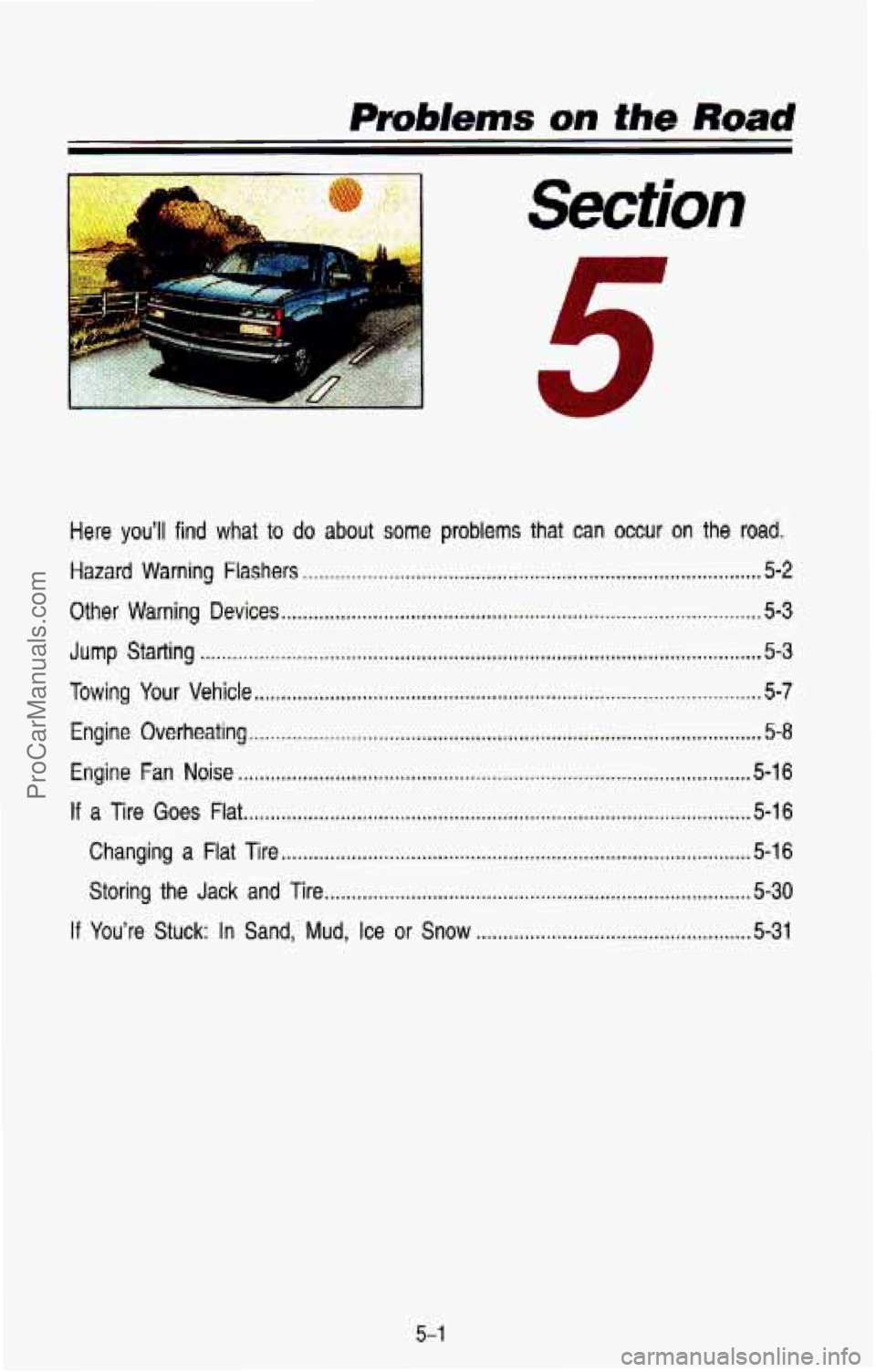
Here you’ll find what to do about some problems that can occur on the road.
Hazard Warning Flashers ........................................................................\
............. 5-2
Other Warning Devices ........................................................................\
................. 5-3
Jump Starting ........................................................................\
................................ 5-3
Towing Your Vehicle, ........................................................................\
..................... 5-7
Engine Overheating ........................................................................\
....................... 5-8
Engine Fan Noise ........................................................................\
....................... 5-1 6
If a Tire Goes Flat ........................................................................\
...................... 5-16
Changing a Flat
Storing the Jack
If You’re Stuck: In
Tire ........................................................................\
............... 5-16
and
Tire. ........................................................................\
...... 5-30
Sand, Mud, Ice or Snow ................................................... 5-31
5-1
ProCarManuals.com
Page 238 of 386
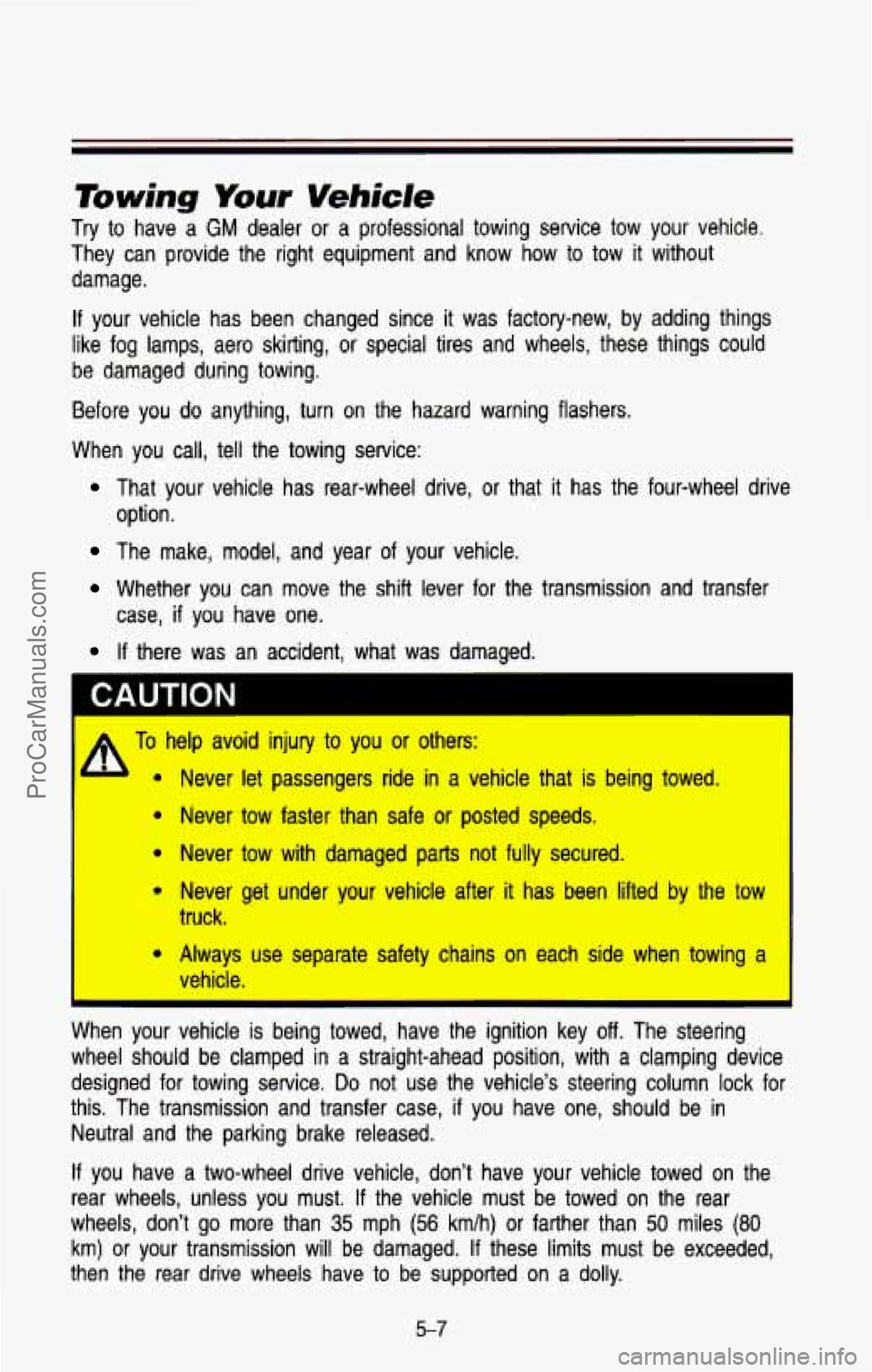
Tiwing Your Vehicle
Try to have a GM dealer or a professional towing service tow your vehicle.
They can provide the right equipment and know how to tow
it without
damage.
If your vehicle has been changed since it was factory-new, by adding things
like fog lamps, aero skirting,
or special tires and wheels, these things could
be damaged during towing.
Before you
do anything, turn on the hazard warning flashers.
When you call, tell the towing service:
That your vehicle has rear-wheel drive, or that it has the four-wheel drive
option.
The make, model, and year of your vehicle.
Whether you can move the shift lever for the transmission and \
transfer
If there was an accident, what was damaged.
case,
if you have one.
CAUTION I
To help avoid
injury to you or others:
A 9 Never let passengers ride in a vehicle that is being towed.
e Never tow faster than safe or posted speeds.
e Never tow with damaged parts not fully secured.
Never get under your vehicle after it has been lifted by the tow
truck.
* Always use separate safety chains on each side when towing a
vehicle.
When your vehicle is being towed, have the ignition key off. The steering
wheel should be clamped in a straight-ahead position, with a clamping device
designed for towing service.
Do not use the vehicle’s steering column lock for
this. The transmission and transfer case,
if you have one, should be in
Neutral and the parking brake released.
If you have a two-wheel drive vehicle, don’t have your vehicle \
towed on the
rear wheels, unless you must.
If the vehicle must be towed on the rear
wheels, don’t
go more than 35 mph (56 kmlh) or farther than 50 miles (80
km) or your transmission will be damaged. If these limits must be exceeded,
then the rear drive wheels have to be supported on a dolly.
5-7
ProCarManuals.com
Page 239 of 386
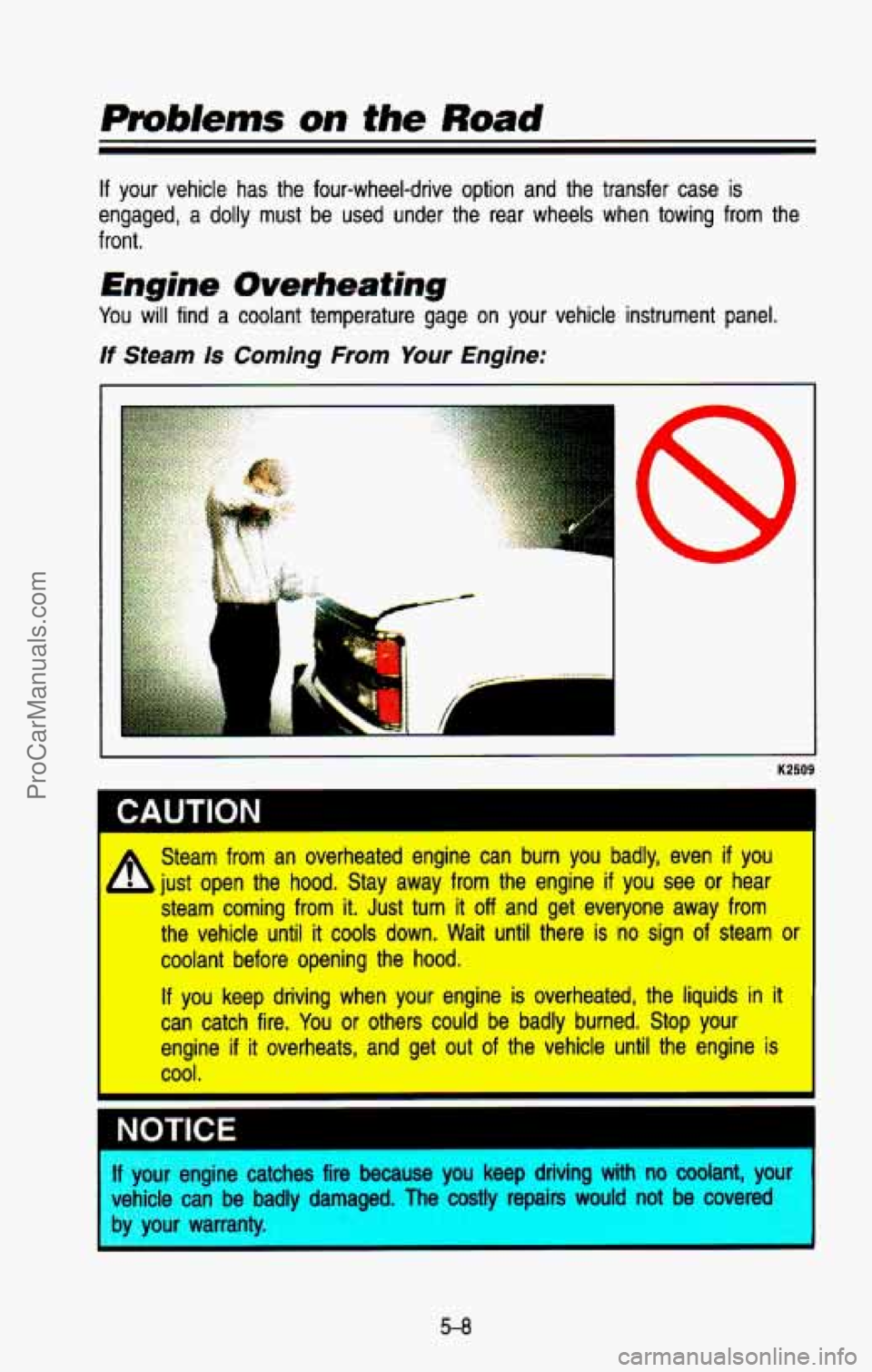
Pmbkms on the Road
If your vehicle has the four-wheel-drive option and the transfer case is
engaged,
a dolly must be used under the rear wheels when towing from the
front.
Engine Overheating
You will find a coolant temperature gage on your vehicle instrument panel,
If Steam Is Coming From Your Engine:
I
‘i Steam from an overheated engine can bum you badly, even if you
just open the hood. Stay away from the engine if you see or hear
steam coming from it. Just turn it off and get everyone away from
the vehide until it cools down. Wait until there is no sign of steam or
coalant before opening the hood.
If you keep driving when your engine is overheated, the liquids in it
can catch fire. You or others could be badly burned. Stop your
engine if it overheats, and get out of the vehicle until the engine is
Cool.
you keep driving with no coolant, your
costly repairs would not be covered
by
your warranty.
5-8
ProCarManuals.com
Page 247 of 386
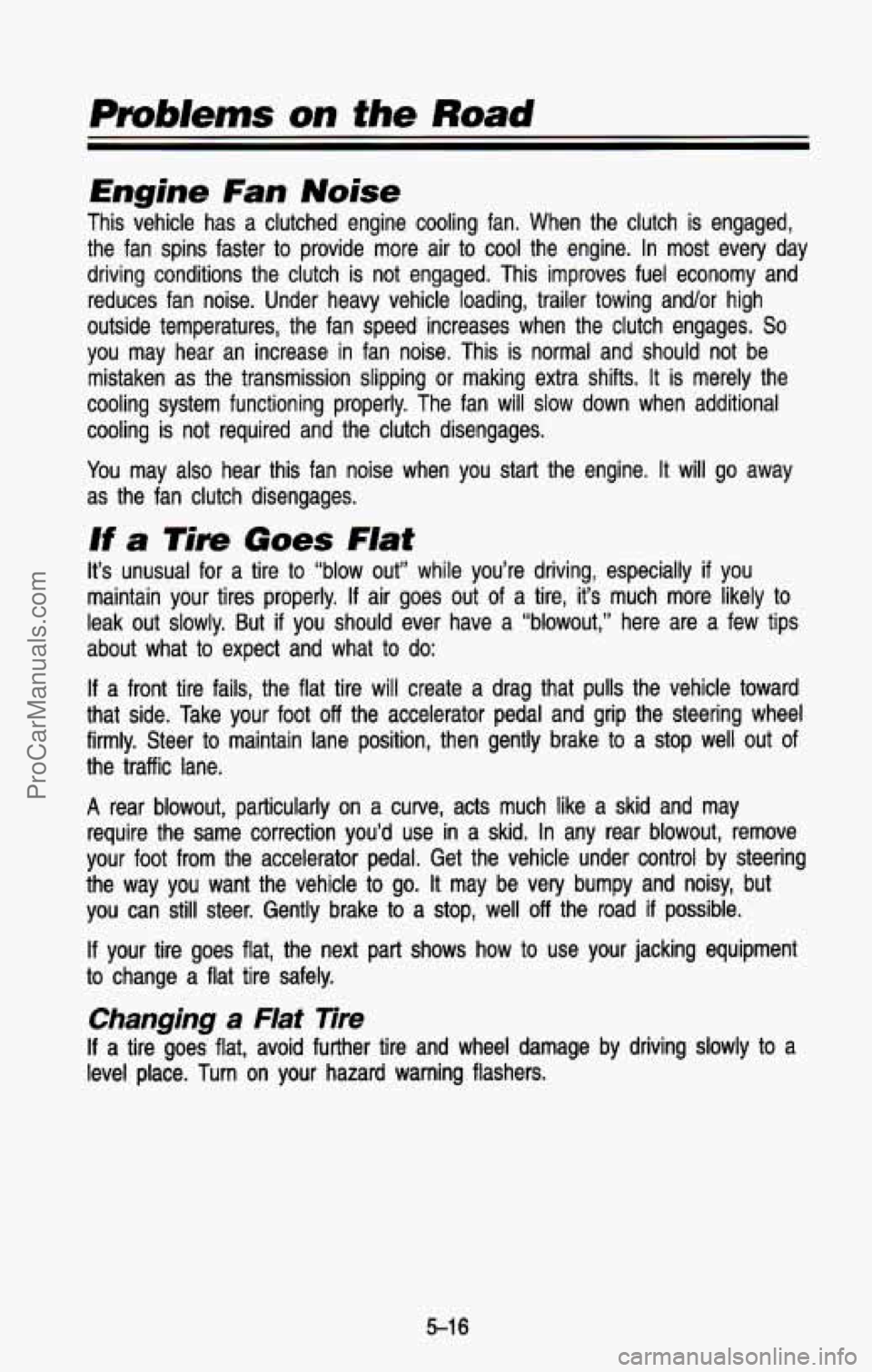
Engine Fan Noise
This vehicle has a clutched engine cooling fan. When the clutc\
h is engaged,
the fan spins faster
to provide more air to cool the engine. In most every day
driving conditions the clutch is not engaged. This improves fuel economy and
reduces fan noise. Under heavy vehicle loading, trailer towing \
and/or high
outside temperatures, the fan speed increases when the clutch e\
ngages.
So
you may hear an increase in fan noise. This is normal and sh\
ould not be
mistaken
as the transmission slipping or making extra shifts. It is merely the
cooling system functioning properly. The fan
will slow down when additional
cooling is not required and the clutch disengages.
You may also hear this fan noise when you start the engine. \
It will go away
as the fan clutch disengages.
If a Tire Goes Fiat
It’s unusual for a tire to “blow out” while you’re driving,\
especially if you
maintain your tires properly.
If air goes out of a tire, it’s much more likely to
leak out slowly. But if you should ever have a “blowout,” here are a few tips
about what
to expect and what to do:
If a front tire fails, the flat tire will create a drag that pulls the vehicle toward
that side. Take your foot
off the accelerator pedal and grip the steering wheel
firmly. Steer to maintain lane position, then gently brake
to a stop well out of
the traffic lane.
A rear blowout, particularly on a curve, acts much like a skid and may
require the same correction you’d use in a skid. In any rear blowout, remove
your foot from the accelerator pedal. Get the vehicle under co\
ntrol by steering
the way you want the vehicle
to go. It may be very bumpy and noisy, but
you can still steer. Gently brake to a stop, well off the road if possible.
If your tire goes flat, the next part shows how to use your jacking equipment
to change a flat tire safely.
Changing a Flat Tire
If a tire goes flat, avoid further tire and wheel damage by driving slowly to a
level place. Turn
on your hazard warning flashers.
5-1 6
ProCarManuals.com
Page 263 of 386
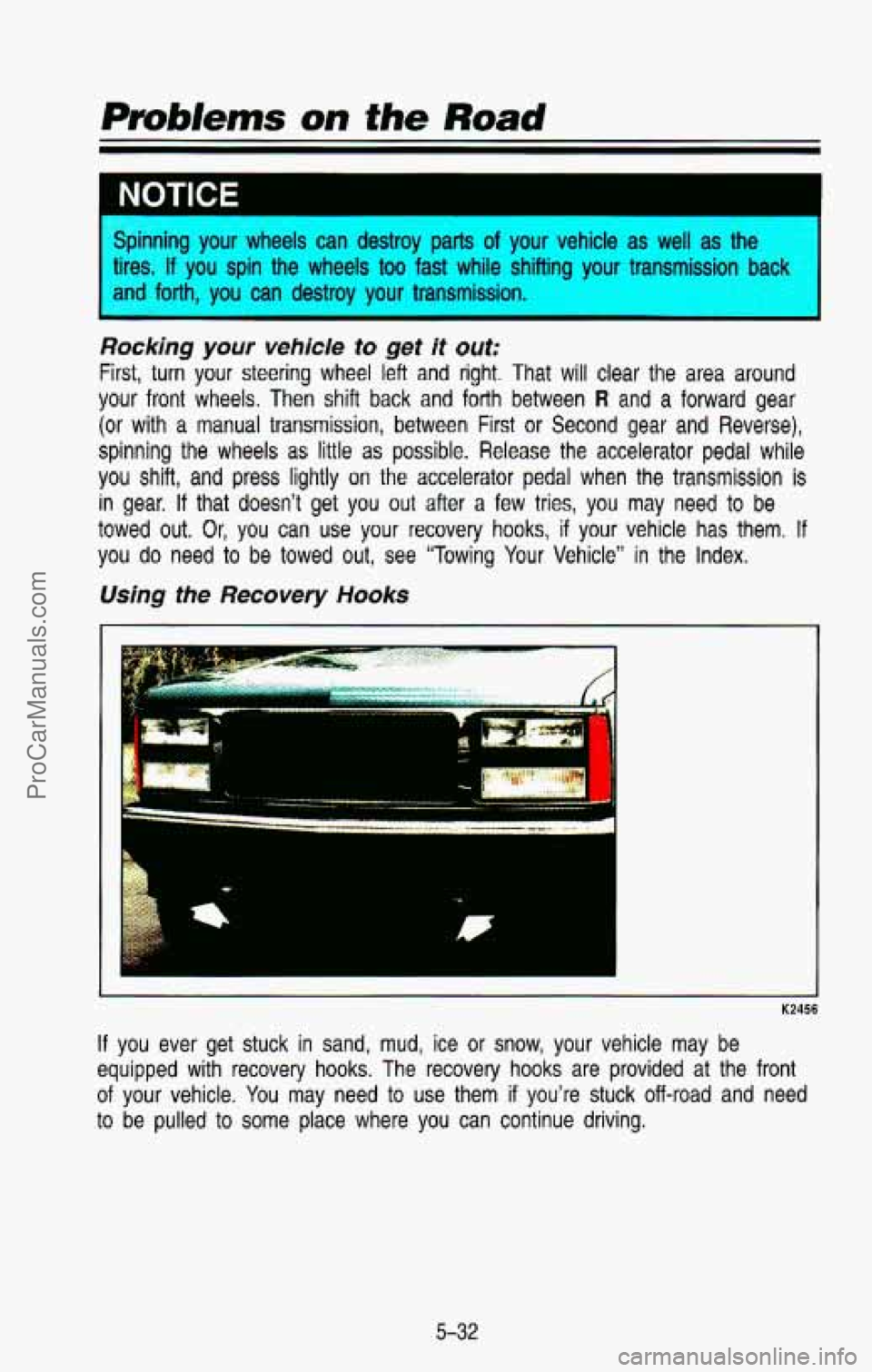
Pmb/ems on the Road
Spinning your wheels can destroy parts of your vehicle as well as the
Rocking your vehicle to get it out:
First, turn your steering wheel left and right. That will clear the area around
your front wheels. Then shift back and forth between R and a forward gear
(or with a manual transmission, between First or Second gear and Reverse),
spinning the wheels as little as possible. Release the accelerator pedal while
you shift, and press lightly on the accelerator pedal when the transmission is
in gear. If that doesn’t get you out after a few tries, you may need to be
towed out. Or, you can use your recovery hooks, if your vehicle has them. If
you do need to be towed out, see “Towing Your Vehicle” in the Index.
Using the Recovery Hooks
m
K2456
If you ever get stuck in sand, mud, ice or snow, your vehicle may be
equipped with recovery hooks. The recovery hooks are provided a\
t the front
of your vehicle. You may need to use them if you’re stuck off-road and need
to be pulled to some place where you can continue driving.
5-32
ProCarManuals.com
Page 358 of 386
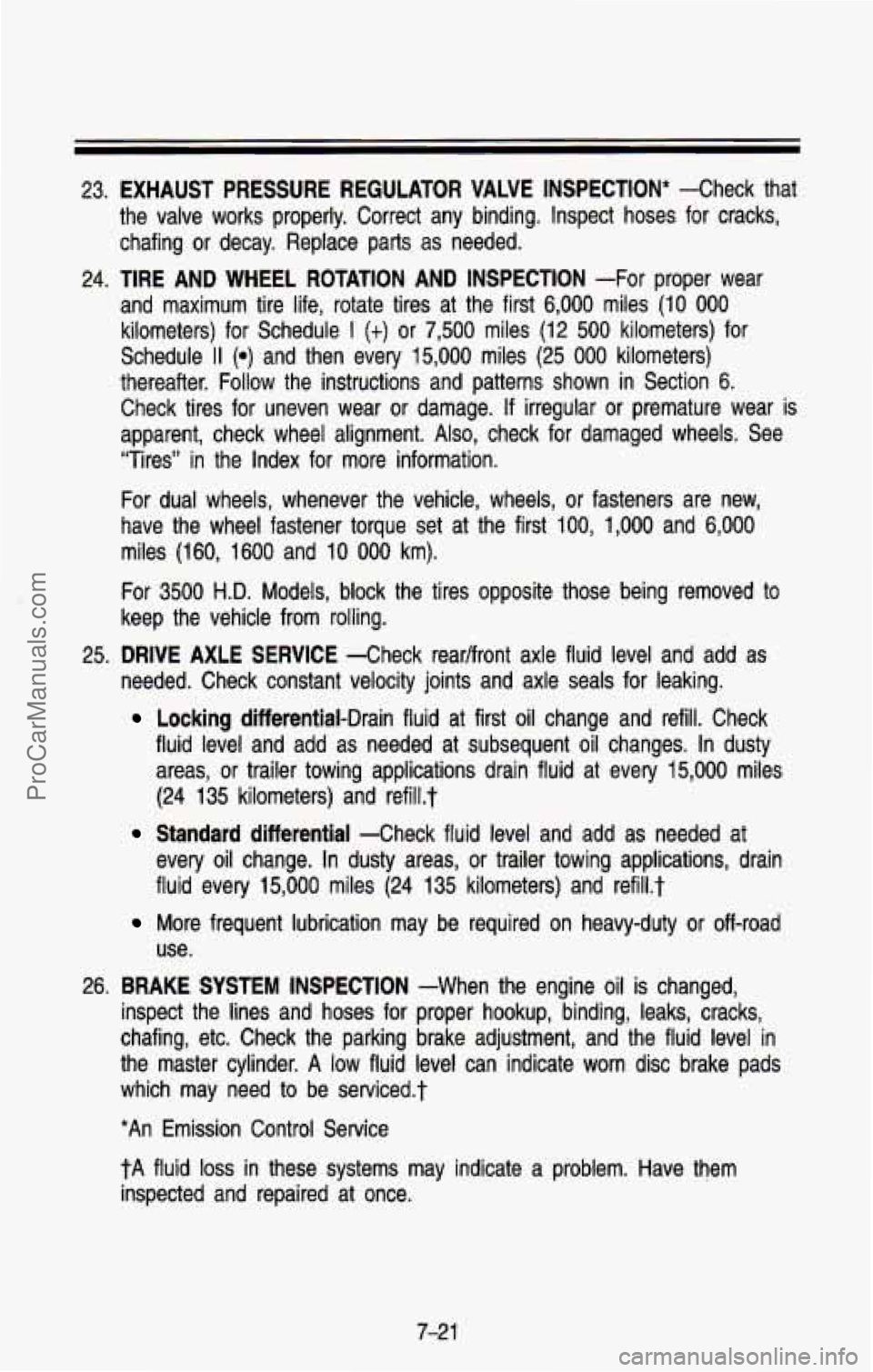
23. EXHAUST PRESSURE EGULATOR VALVE INSPECTION* -Check that
the valve works properly. Correct any binding. Inspect hoses fo\
r cracks,
chafing or decay. Replace parts
as needed.
24. TIRE AND WHEEL ROTATION AND INSPECTION -For proper wear
and maximum tire life, rotate tires
at the first 6,000 miles (10 000
kilometers) for Schedule I (t) or 7,500 miles (12 500 kilometers) for
Schedule
II (.) and then every 15,000 miles (25 000 kilometers)
thereafter.
Follow the instructions and patterns shown in Section 6.
Check tires for uneven wear or damage. If irregular or premature wear is
apparent, check wheel alignment.
Also, check for damaged wheels. See
“Tires” in the Index for more information.
For dual wheels, whenever the vehicle, wheels, or fasteners are new\
,
have the wheel fastener torque set at the first 100,
1,000 and 6,000
miles
(160, 1600 and 10 000 km).
For
3500 H.D. Models, block the tires opposite those being removed to
keep the vehicle from rolling.
25.
DRIVE AXLE SERVICE -Check readfront axle fluid level and add as
needed. Check constant velocity joints and axle seals for leaki\
ng.
Locking differential-Drain fluid at first oil change and refill. Check
fluid level and add as needed at subsequent oil changes. In dusty
areas, or trailer towing applications drain fluid at every
15,000 miles
(24 135 kilometers) and refill$
every oil change. In dusty areas,
or trailer towing applications, drain
fluid every 15,000 miles
(24 135 kilometers) and refi1l.t
Standard differential -Check fluid level and add as needed at
More frequent lubrication may be required on heavy-duty or off-road
use.
26. BRAKE SYSTEM INSPECTION -When the engine oil is changed,
inspect the lines
and hoses for proper hookup, binding, leaks, cracks,
chafing, etc. Check the parking brake adjustment, and the fluid level in
the master cylinder.
A low fluid level can indicate worn disc brake pads
which may need to be serviced$
*An Emission Control Service
tA fluid loss in these systems may indicate a problem. Have them
inspected and repaired
at once.
7-2 1
ProCarManuals.com
Page 372 of 386
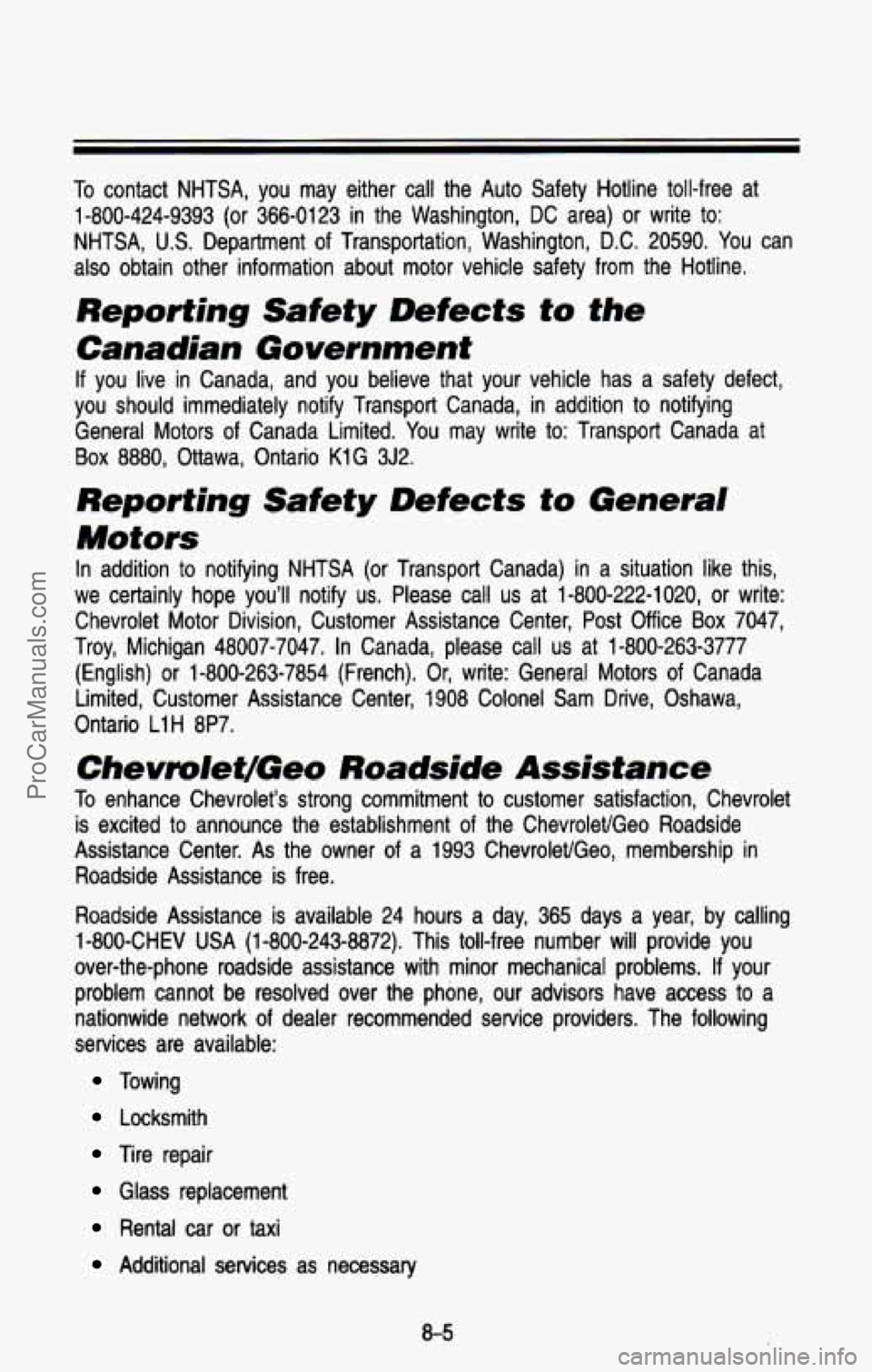
To contact NHTSA, you may either call the Auto Safety Hotline tol\
l-free at
1-800-424-9393
(or 366-0123 in the Washington, DC area) or write to:
NHTSA,
U.S. Department of Transportation, Washington, D.C. 20590. You can
also obtain other information about motor vehicle safety from t\
he Hotline.
Reporting Safety Defects to the
Canadian Government
If you live in Canada, and you believe that your vehicle has \
a safety defect,
you should immediately notify Transport Canada, in addition to notifying
General Motors of Canada Limited. You may write to: Transport Canada at
Box 8880, Ottawa, Ontario K1G 3J2.
Reporting Safety Defects to General
Motors
In addition to notifying NHTSA (or Transport Canada) in a situation like this,
we certainly hope you’ll notify
us. Please call us at 1-800-222-1 020, or write:
Chevrolet Motor Division, Customer Assistance Center,
Post Office Box 7047,
Troy, Michigan 48007-7047. In Canada, please call us at 1-800-263-3777
(English)
or 1-800-263-7854 (French). Or, write: General Motors of Canada
Limited, Customer Assistance Center, 1908 Colonel Sam Drive, Osh\
awa,
Ontario L1H 8P7.
Chevmlet/Geo Roadside Assistance
To enhance Chevrolet’s strong commitment to customer satisfaction,\
Chevrolet
is excited to announce the establishment
of the ChevroletlGeo Roadside
Assistance Center. As the owner of a 1993 ChevroleVGeo, members\
hip in
Roadside Assistance is free.
Roadside Assistance is available
24 hours a day, 365 days a year, by calling
1-800-CHEV
USA (1 -800-243-8872). This toll-free number will provide you
over-the-phone roadside assistance with minor mechanical problems.\
If your
problem cannot be resolved over the phone, our advisors have a\
ccess to a
nationwide network of deater recommended service providers. The \
following
services are available:
Towing
Locksmith
Tire repair
Glass replacement
Rental car or taxi
Additional services as necessary
ProCarManuals.com
Page 380 of 386

M
Maintenance Other Items
............................... 6-34
Periodic Inspections
................. 7-24
Record
............................... 7.3. 7-27
Scheduled Maintenance
.. 7.4. 7-1 8
Underbody
................................ 6-62
When Towing a Trailer
............. 4-63
Master Cylinder (See “Brakes”)
Mirrors
........................................... 2-51
Convex Outside
........................ 2-52
Electric Outside
........................ 2-52
Inside
.......................................... 2-51
Model Reference
............................... III
Multifunction Lever ...................... 2-36
...
Turn SignalLane
Change Indicator
........... 2-37, 2-75
0
Odometer ....................................... 2-66
Off-Road Driving (See “Driving”)
Off-Road Recovery
..................... 4-20
Oil ..................................................... 6-9
Additives
................................... 6-1 5
Disposal of Used ...................... 6-1 6
Pressure Gage
.......................... 2-78
To Check
................................... 6-1 0
What Kind to Use .................... 6-12
When
to Add ............................ 6-10
When
to Change ...................... 6-1 5
Owner Checks and Services ...... 7-22
Parking On Hills
...................................... 4.49
Over Things That Burn
............ 2-27
Torque Lock (Automatic
Transmission)
............. 2.24. 4-52
Your Vehicle (Manual Transmission)
........................ 2-26
Parking Brake
............................... 2-23
Passing
Other Vehicles .... 4.21. 4-61
Pavement Markings
........................ 4-8
Periodic Maintenance
Power Inspections
................................ 7-24
Door Locks
.................................. 2-7
Steering
..................................... 4-18
Steering Fluid
........................... 6-29
Winches
..................................... 4-64
Product Service Publications
....... 8-6
R
Radiator Pressure Cap ................ 6-28
Radio (See “Audio Systems”)
Rear Window Defogger
.............. 3-11
Recommended Fluids And Lubricants
......................... 7-25
Recovery Hooks
........................... 5-32
Replacement Parts
...................... 6-68
Reporting Safety Defects
............. 8-4
Road Signs
..................................... 4-2
Roadside Assistance
..................... 8-5
Rocking Your Vehicle
.................. 5-32
S
Safety Belts .................................. 1-13
Center Passenger
........... 1-27, 1-29
Cleaning
..................................... 6-60
Checking Restraint System
.... 1-47
Child Restraints
........................ 1-36
Children
...................................... 1-34
Driver Position
.......................... 1-20
Extender
.................................... 1-46
Lap Shoulder
............................ 1-21
Larger Children
......................... 1-44
Proper Wear
............................. 1-20
Questions and Answers
.......... 1-18
Rear Seat
.................................. 1-30
Replacing After a Crash
......... 1-47
Right Front Passenger
............ 1-27
Small Children and Babies
..... 1-34
Use During Pregnancy
............ 1-26
Why They Work ....................... 1-15
Adults
......................................... 1-20
Reminder Light
......................... 1-19
9-5
ProCarManuals.com